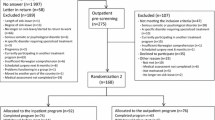Abstract
The purpose of this study was to determine factors related to return to work following the completion of a Work-Oriented Occupational Therapy Program (WOOTP). This program is conducted at the Department of Occupational Therapy, National Taiwan University Hospital, Taipei, Taiwan, Republic of China. One hundred and twelve subjects were discharged from WOOTP between November 1, 1995 and May 31, 1997. Forty-five (40.2%) subjects returned to work. Univariate analysis showed that gender, marital status, area of injury, subject's physical capacity level, and change in physical demand level after WOOTP, ADL, and job waiting related to return-to-work status following the completion of WOOTP. Factors related to return to work were compared bivariately using forward stepwise logistic regression procedures. Results indicated that ADL, gender, and marital status contributed significantly to the logistic regression model. Those most likely to return to work were female, married, and/or that they had higher Barthel ADL index scores. It was concluded that further research was needed to determine the applicability of these results to broader groups of subjects, and to refine and expand the predictive model to include other relevant factors.
Similar content being viewed by others
REFERENCES
Cromwell FS. Work-related programming in occupational therapy: Its roots, course and prognosis. Occup Ther in Health Care 1985; 2: 9-25.
Turner A. The practice of occupational therapy: An introduction to the treatment of physical dysfunction. New York: Churchill Livingstone, 1987, pp. 245-258.
American Occupational Therapy Association. Representative assembly: Summary of minutes. Am J Occup Ther 1986; 40: 851-853.
American Occupational Therapy Association. Statement: Occupational therapy services in work practice. Am J Occup Ther 1992; 46: 1086-1088.
Turner A, Foster M, Johnson SE. Occupational therapy and physical dysfunction: Principles, skills and practice. New York: Churchill Livingstone, 1996, pp. 1-25.
Graly JM, Yi S, Jensen GM, Gibson M, Laborde T. Factors influencing return to work for clients in a work-hardening center. Work 1994; 4: 9-21.
Moffroid MT, Aja D, Haugh LD, Henry S. Efficacy of a part-time work hardening program for persons with low-back pain. Work 1993; 3:14-20.
Niemeyer LO, Jacobs K, Reynolds-Lynch K, Bettencourt C, Lang S. Work hardening: Past, present, and future—the work programs special interest section national work-hardening outcome study. Am J Occup Ther 1994; 48: 327-339.
Voaklander DC, Beaulne AP, Lessard RA. Factors related to outcome following a work hardening program. J Occup Rehabil 1995; 5: 71-85.
Bear-Lehman J. Workers disability and return to work. Am J Occup Ther 1983; 37: 189-194.
Black-Schaffer RM, Osberg JS. Return to work after stroke: Development of a predictive model. Arch Phys Med Rehab 1990; 71: 286-290.
Lyons JL, Morse AR. A therapeutic work program for head injured adults. Am J Occup Ther 1988; 42: 364-370.
Schmidt SH, Oort-Marburger D, Meijman TF. Employment after rehabilitation for musculoskeletal impairments: The impact of vocational rehabilitation and working on a trial basis. Arch Phys Med Rehab 1995; 76: 950-954.
Tate DG. Workers disability and return to work. Am J Phys Med Rehab 1992; 71: 92-96.
Howard G, Till JS, Toole JF, Matthews C, Truscott BL. Factors influencing return to work following cerebral infarction. JAMA 1985; 253: 226-232.
Krause JS. Employment after spinal cord injury. Arch Phys Med Rehab 1992; 73: 163-169.
Mackenzie EJ, Shapiro S, Smith RT, Siegel JH, Moody M, Pitt A. Factors influencing return to work following hospitalization for traumatic injury. Am J Pub Health 1987; 77: 329-334.
U.S. Department of Labor. Selected characteristics of occupations defined in the revised Dictionary of Occupational Titles. Washington, DC: U.S. Government Printing Office, 1993.
Wade DT, Collin C. The Barthel ADL index: A standard measure of physical disability? Int Disab Studies 1988; 10: 64-67.
SPSS, Inc. SPSS for Windows, Release 6.1.3. Chicago: SPSS, 1993.
Gage M, Cook JV, Fryday-Field K. Understanding the transition to community living after discharge from an acute care hospital: An exploratory study. Am J Occup Ther 1997; 51: 96-103.
DipCOT RC. An investigation into the employment and occupation of patients with a spinal cord injury. Paraplegia 1994; 32: 182-187.
Author information
Authors and Affiliations
Rights and permissions
About this article
Cite this article
Jang, Y., Li, W., Hwang, MT. et al. Factors Related to Returning to Work Following a Work-Oriented Occupational Therapy Program for Individuals with Physical Disabilities. J Occup Rehabil 8, 141–151 (1998). https://doi.org/10.1023/A:1023067707057
Issue Date:
DOI: https://doi.org/10.1023/A:1023067707057




